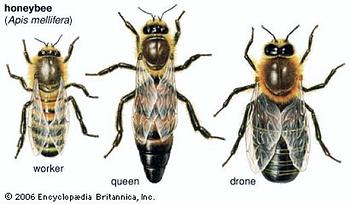Honey Bee Facts
 Bees kept by beekeepers, the Western Honey Bee (Apis mellifera) (also called the European Honey Bee), is one of about seven kinds of honey bee worldwide. There are also about 20 species of Bumblebees and at least 250 species of solitary bees in Britain.
Bees kept by beekeepers, the Western Honey Bee (Apis mellifera) (also called the European Honey Bee), is one of about seven kinds of honey bee worldwide. There are also about 20 species of Bumblebees and at least 250 species of solitary bees in Britain.
A honey bee colony consists of three castes of bee:
The queen, who is mother to all the other bees in the colony.
Workers (female bees) numbering about 10,000 in winter rising to some 50,000 or more in summer .
Drones (male bees) In summer the colony contains from 200 - 1000 drones, but there are none in the winter.
PRODUCTS OF THE HIVE

Our honey bees are doing what they have done for millions of years - and their Honey must surely be one of the few foods unchanged by man. Apart from honey other products of a Colony are Beeswax, Royal Jelly, Pollen and Propolis. Royal Jelly is produced from certain glands of the worker bee and is fed to the developing larvae. Pollen is collected by worker bees and carried back to the hive on its rear legs. It is a high protein bee food. Propolis is made by the bees from plant resin. They use it to strengthen and waterproof the hive, and it is known to have valuable antibiotic properties. Beeswax has many uses, including candles, polishes, in beauty products and in certain pharmaceuticals.
FLOWERS AND NECTAR

The annual cycle of flowers producing nectar and/or pollen more or less follows: hazel, soft fruit, top fruits, holly, maple, sycamore, oil seed rape, field bean, marigold, limetrees and later, heather. Of course, the precise source of nectar will depend upon the season and locality.